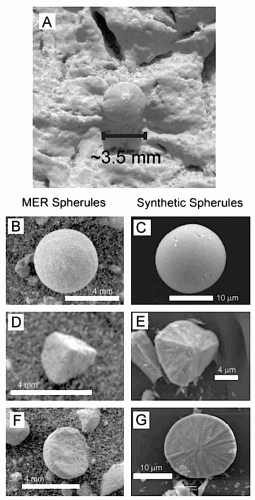The relative amount of three chemical elements contained in Martian “blueberries” might offer scientists a way to date when these spherules were last inundated with water, according to recent research.

CATCH A DATE. Mars rover Opportunity found "blueberries" — spherules a few millimeters across — littering the ground and buried in the sediments of Meridiani Planum. These are hematite-rich concretions that formed within rocks when the sediments became soaked with groundwater. Lab experiments suggest a way to use ratios of uranium, thorium, and helium within the blueberries to date the last time water touched the sediments. (Image taken from Figure 1 in the paper.)
Rich in the iron mineral hematite, blueberries are small concretions, a few millimeters in diameter, that formed within the soft sandstones of Meridiani Planum when they were soaked with groundwater. The spherules were a key discovery made by the Mars Exploration Rover Opportunity as soon as it set down on Meridiani in January 2004. The blueberries, being harder than the surrounding sandstone, are weathering out of the rock and littering the surface where Opportunity set down.
A paper in Planetary and Space Science by Syracuse University scientists Joseph Kula and Suzanne Baldwin suggests that ages measured using the relative abundances of uranium, thorium, and helium in the blueberries could yield the time that has passed since water last wetted the sediments.
Although potassium and argon isotopes have been used by scientists for dating rocks much more often, Kula and Baldwin note that for more than a century, geologists have known that hematite retains helium produced by the radioactive decay of uranium and thorium. Measuring the relative abundances produces an age.
To test a crucial proviso — that the blueberries not lose any significant amount of helium since the wetting occurred roughly 4 billion years ago — Kula and Baldwin recalculated previously determined laboratory measurements for helium in variously shaped bits of hematite. These data were then coupled to the various shapes of blueberries observed by Opportunity.
They found that even if warm temperatures persisted over the last 4 billion years of Mars history, enough helium should be retained under Martian conditions to keep the method viable. Previously, they had examined how argon behaves in the iron-sulfate mineral jarosite, which is common at Meridiani. Jarosite would provide an alternate check on the process.
“Coupled jarosite and hematite ages could therefore constrain the timing and rates of groundwater movement,” they write, thus tracking the environmental transition from water-saturated conditions to arid.
There’s also a possible use by Curiosity, NASA’s Mars Science Laboratory rover, on target for an August 2012 landing in Gale Crater. Kula and Baldwin explain, “If Curiosity encounters hematite spherules, it can likely extract and measure helium using the ovens and mass spectrometer in the Sample Analysis at Mars (SAM) instrument.”
Measurement of the parent uranium and thorium is more problematic, they say, but “if these trace elements are of high enough abundance, measurement may be possible by gamma ray spectroscopy.”
In any case, they note, blueberries and other hematite-bearing rocks would be good samples to collect with an eye to retuning them to Earth in any future mission.








